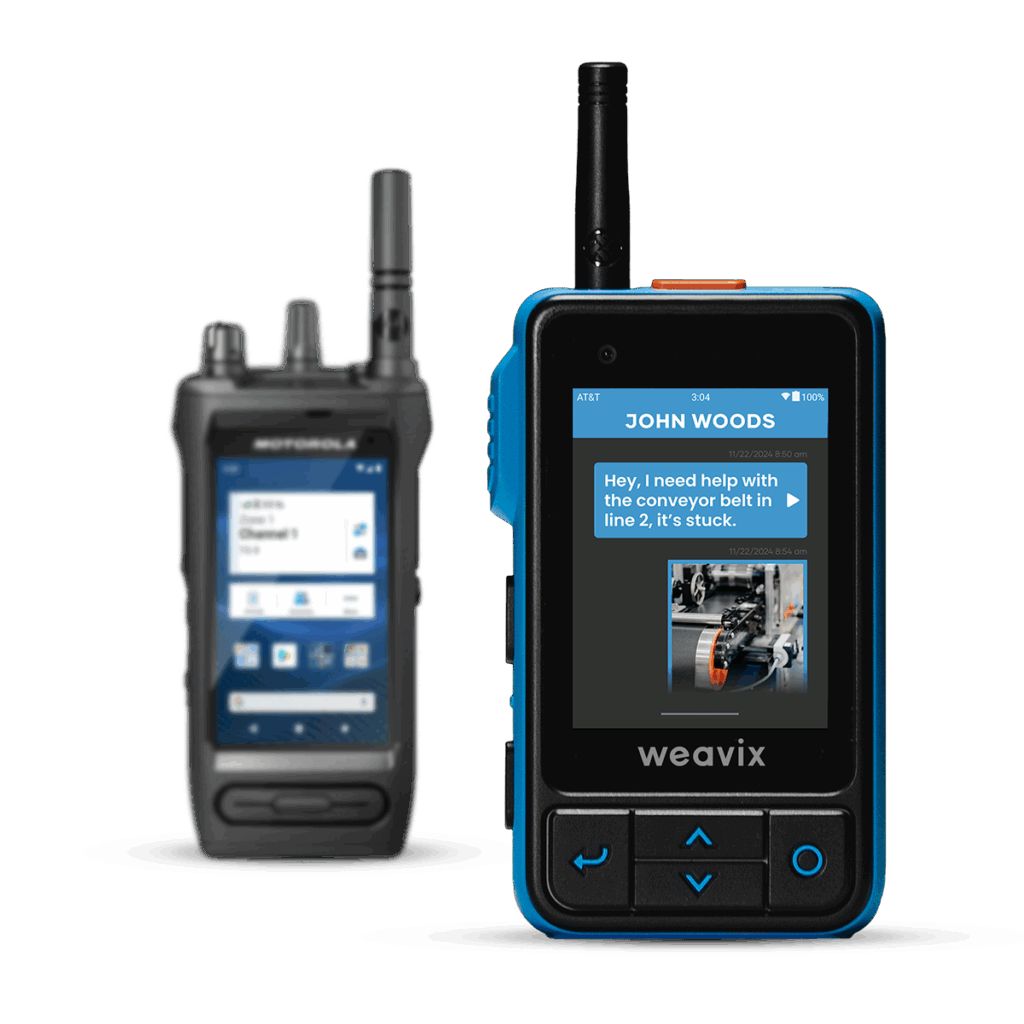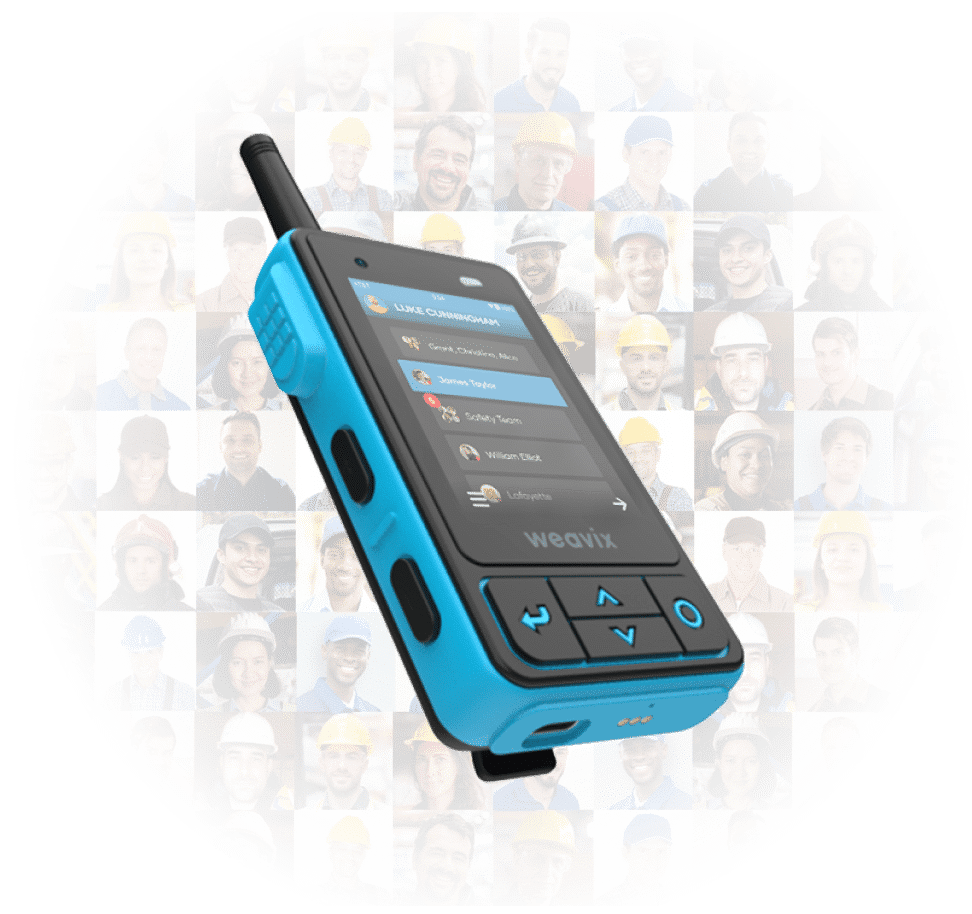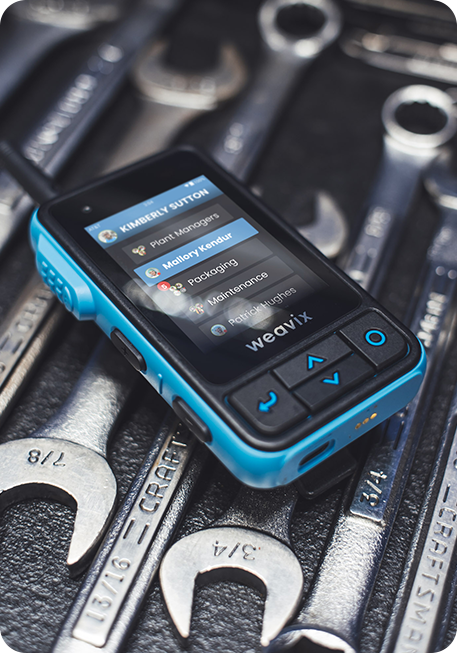Two-Way Radio Comparison: Walt vs Motorola ion
Walt Smart Radio System vs. Motorola Ion
This Two-Way Radio Comparison between the Weavix Walt Smart Radio System and the Motorola Ion reveals how smart radios designed for the frontline outperform hybrid legacy options in safety, cost, and scalability.
Walt Smart Radio combines durability with workforce scalability and compliance — at a fraction of Ion’s cost.
Walt Smart Radio isn’t just another radio; it’s a frontline communications platform.

TL;DR
Motorola Ion: Android-based two-way radio with push-to-talk and app support, but expensive, license-restricted, and not intrinsically safe.
Walt Smart Radio System: Enterprise-wide LTE/Wi-Fi coverage, no FCC license, rugged and intrinsically safe, with advanced safety solutions.
Why This Comparison Matters
Hybrid designs look powerful on paper, but real differences emerge in cost, licensing, and safety. Walt Smart Radio System proves more effective where it counts.
Walt Smart Radio
Walt Smart Radio was built specifically for industrial frontline workers. The Walt Smart Radio System combines rugged hardware, enterprise-wide scalability, and built-in safety features to deliver more value, without the hidden costs of legacy or hybrid radios.
- No FCC license required
- Lower total cost; no licenses or repeaters
- C1D2 intrinsically safe, IP68 rated, built for hazardous environments
Motorola Ion
Motorola Ion is marketed as a “smart radio” — combining Android apps with push-to-talk capability. While it introduces more flexibility than legacy radios, Ion is costly, license-dependent, and lacks intrinsic safety, limiting its suitability for hazardous frontline environments.
- Requires FCC license for RF channels
- Higher upfront and ongoing licensing costs
- Rugged but not intrinsically safe.
Comparison Table
How Motorola Ion and Walt Smart Radio System differ on coverage, safety, compliance, and cost — the factors that matter most in frontline operations.
Feature | Walt Smart Radio System | Motorola Ion |
|---|---|---|
Coverage | Nationwide LTE/Wi-Fi coverage + FRS backup + SimulCast | RF + LTE/Wi-Fi hybrid; requires repeaters for full RF coverage |
Safety Features | SOS with ID, GPS location, lone-worker protection, incident logging | Standard emergency alert |
Communication | Unlimited channels, group talk, private 1:1, broadcast, multimedia (text, photo, video) | Push-to-talk voice + Android app integration |
Licensing | No FCC license required | Requires FCC license for RF channels |
Scalability | Enterprise-wide scalability without repeaters | Hybrid model still needs repeaters for RF expansion |
Ruggedness | C1D2 intrinsically safe, IP68, drop/dust/water resistant, hardened touchscreen | Rugged; not intrinsically safe for hazardous sites |
Cost of Ownership | Lower total cost; no licenses or repeaters | Higher upfront and ongoing licensing costs |
Key Finding: Walt Smart Radio Outperforms at Lower Cost
While Motorola Ion blends RF and LTE, it inherits the downsides of traditional radios: FCC licensing, repeaters, and limited intrinsic safety. It also carries a significantly higher price tag.
Walt Smart Radio delivers broader coverage and enterprise-wide scalability at lower cost — while adding advanced safety and compliance features designed for hazardous industrial environments.


Never Buy a Dumb Radio Again.
Equip your workers with the Walt Smart Radio System. Move beyond your perception of what a radio should do. Walt is more than a radio, it’s a frontline communication and safety platform that enables every worker.
>> Learn how the Walt Smart Radio System sets the standard for modern industrial communication.
Operational Differences That Matter
Product specifications do not show how these tools perform in practice. Here is how Ion and Walt Smart Radio System compare in real-world operations
Coverage
Walt Smart Radio: LTE/Wi-Fi nationwide coverage with FRS backup and SimulCast, no repeaters required.
Motorola Ion falls short:
Dual-mode (RF + LTE/Wi-Fi), but still requires repeaters for RF coverage.
Safety
Walt Smart Radio: SOS alerts include worker ID, GPS location, lone-worker protection, and incident logging.
Motorola Ion falls short:
Standard emergency button with limited functionality.
Communication
Walt Smart Radio: Unlimited channels plus private/group talk, multimedia messaging, and enterprise-level workforce features.
Motorola Ion falls short:
Push-to-talk and access to Android apps.
Licensing and Cost
Walt Smart Radio: No FCC licensing, no repeaters, and a lower total cost of ownership.
Motorola Ion falls short:
Requires FCC licenses for RF channels and repeaters for RF expansion.
Ruggedness
Walt Smart Radio: C1D2 intrinsically safe, IP68 rated, built for hazardous environments.
Motorola Ion falls short:
Rugged but not intrinsically safe.

Beyond Hybrid Radios: Why Walt Smart Radio is Different
Motorola Ion tries to bridge the gap between radios and smartphones, but in doing so it inherits the cost and compliance burdens of both. Walt Smart Radio was built from the ground up as a frontline communications platform — safe, scalable, and cost-efficient, without the trade-offs.
A Trusted Partner in Frontline Enablement
Conclusion
Motorola Ion offers app support and hybrid connectivity, but its high cost, licensing requirements, and lack of intrinsic safety make it a limited solution for enterprise-scale industrial use.
Walt Smart Radio removes those barriers. With nationwide coverage, advanced safety solutions, rugged intrinsically safe design, and lower total cost, the Walt Smart Radio System is not just a radio — it’s a frontline communications platform.
Ready to see how Walt Smart Radio compares to Motorola Ion in your environment?

Frequently Asked Questions
Does Motorola Ion require an FCC license?
Yes. RF channels still require FCC licensing, adding ongoing costs. Walt Smart Radio requires no FCC license.
Is Motorola Ion intrinsically safe?
No. Motorola Ion is rugged but not certified for hazardous environments. Walt Smart Radio is intrinsically safe (C1D2).
Can Motorola Ion scale across multiple sites?
Not without repeaters and separate RF systems. Walt Smart Radio provides enterprise-wide scalability without repeaters.
How does cost compare between Motorola Ion and Walt Smart Radio?
Ion’s hybrid design leads to higher upfront costs, licensing fees, and infrastructure costs. Walt Smart Radio delivers more at a lower total cost of ownership.


